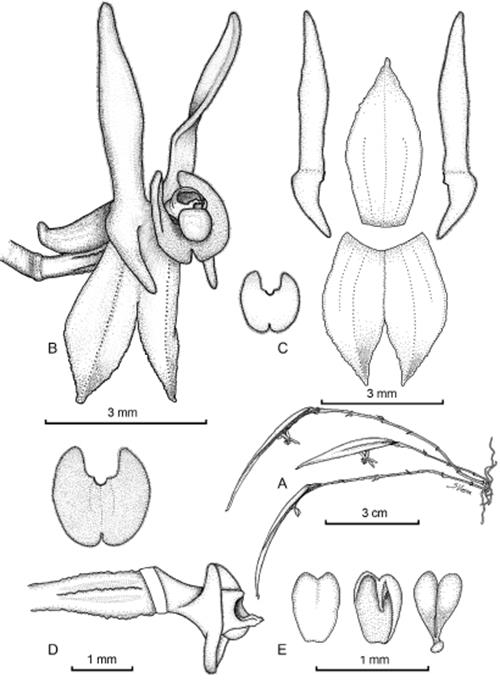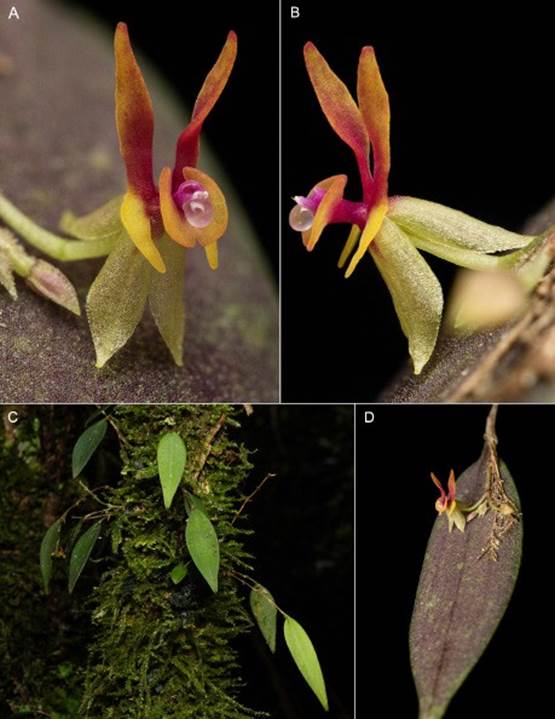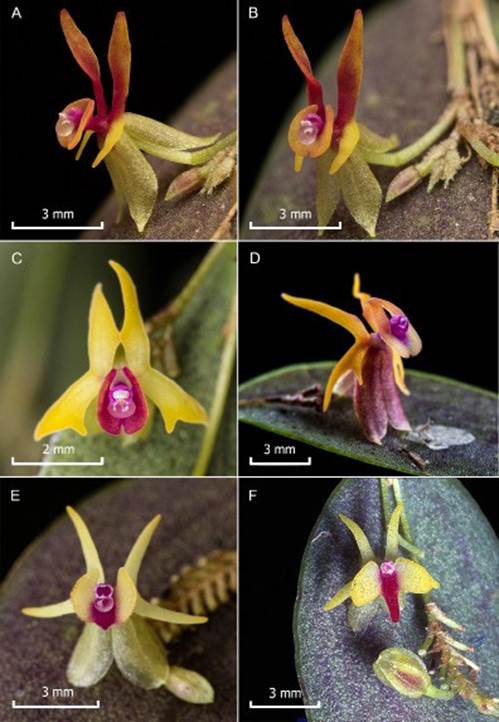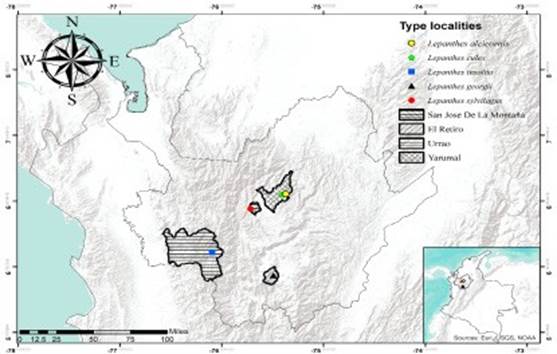Introduction
With around 1160 species (Gutiérrez et al. 2021, Karremans & Vieira-Uribe 2020, Moreno et al. 2020a, 2020b, 2021, Moreno & Vieira-Uribe 2020), Lepanthes Sw. is one of the most species-rich genera in Pleurothallidinae (Karremans 2016, Luer 1996, Luer & Thoerle 2012). Its distribution is strictly neotropical, from the trans-Mexican volcanic belt to the south to Bolivia and northern Brazil, including the Antilles (Jimenéz-López et al. 2017). More than 300 species of Lepanthes have been recorded in Colombia, most of them distributed along the biogeographical regions of the Andes, up to 3800 m in elevation. Many species are endemic, but some are relatively frequent and widely distributed (Luer & Thoerle 2012, Pridgeon 2005). New species in the genus and records for the country are regularly published, so as more field exploration continues, the number of Lepanthes species attributed to Colombia is expected to increase (Gutierrez et al. 2021, Moreno et al. 2017, 2018, 2020a, 2020b, 2021, Moreno & Vieira-Uribe 2020, Vieira-Uribe & Moreno 2019).
Lepanthes species are recognized by the infundibuliform sheaths that are frequently pubescent, ciliated, with a slight to wide, apical dilatation; petals that are usually transversely bilobed to trilobed, and a compound lip having two thickened blades usually covering the column, with a minute basal appendix. Most species of Lepanthes show a structure at the base of the lip called the appendix (Luer 1996). Small fungus gnats likely pollinate the species that bear an appendix via pseudo-copulation (Blanco & Barboza 2005, Vieira-Uribe & Moreno 2019). However, some species in the genus, which is the case of Lepanthes calodictyon Hook. and others apparently related: L. arachnion, L. barbellifera, L. kayii Baquero, L. microcalodictyon J.S.Moreno & L.Baquero, L. pantomima Luer & Dressler, L. pretiosa Luer & Hirtz, L. saltatrix Luer & Hirtz, L. tentaculata Luer & Hirtz, L. tortuosa Luer & Hirtz, and L. volador Luer & Hirtz, lack a visible appendix (Baquero 2018, Bogarín et al. 2019, Moreno et al. 2020b). Another group of species, apparently endemic to the department of Antioquia, Colombia, include Lepanthes alcicornis Luer & R.Escobar, L. culex Luer & R.Escobar, L. georgii Luer & R.Escobar, and L. insolita Luer & R.Escobar. These species are characterized by the flowers with simple, cordate lips without an appendix (Luer & Thoerle 2012). In addition, a new species lacking an appendix recently discovered near San José de la Montaña (also Antioquia department), most similar to Lepanthes alcicornis is described and illustrated here.
Material and methods
The type specimen was collected in Colombia while conducting research on the orchids of Antioquia, under permit Resolución No. 01711. Vouchers were preserved as dried or spirit specimens for future reference at JAUM. Living and preserved specimens were examined for morphological and taxonomic comparisons. The monograph of Lepanthes from Colombia (Luer & Thoerle 2012) and other original descriptions from related species were reviewed and compared, specimens from the following herbaria: AMES, COL (online), CUVC, HUA, JAUM, JBB, and MO (online)were consulted, and no additional material of the new species was found. The description and drawings were prepared from living specimens dissected under a Barska AY11234 trinocular zoom stereo microscope. Digital images were taken with a Canon 7d Mark II with a Canon 100 mm f/2.8L macro lens. Sketches from living and preserved specimens were digitized, and the images were used for diagramming a draft composite plate in Adobe Photoshop® 2020. A digital composite line drawing was made in the Procreate illustration application with an iPad 8th generation tablet.
Taxonomic treatment
Lepanthes sylvilagus E.Restrepo & S.Vieira-Uribe, sp. nov. (Fig.1-2).
TYPE: Colombia. Antioquia: Municipio de San José de la Montaña, vereda La Mariela, bosque secundario a borde de quebrada cerca de la vía a El Congo, 2810 m, diciembre de 2019, S. Vieira-Uribe 53 (holotype: JAUM-Spirit!).
Diagnosis: Lepanthes sylvilagus is most similar to L. alcicornis in the plant habit and general flower morphology, but easily distinguished by the transversely bilobed petals, with the upper lobe oblong to narrowly triangular and twice the length of the ovate, narrowly triangular lower lobe (vs. transversely bilobed petals with both lobes similar in length the lower lobe variably bifurcate, with narrowly linear-triangular lobes).
Plant epiphytic, medium in size, caespitose, suberect to horizontal, to 10 cm tall. Roots slender, flexuous, filiform, up to 0.2 mm in diameter. Ramicauls enclosed by 5-9 lepanthiform sheaths minutely ciliate along the ribs, with a ciliate, acuminate, and dilated ostia, 4-7 cm long. Leaves suffused with purple abaxially, coriaceous, lanceolate, 4.0 × 1.8 cm, the apex attenuate, emarginate; the cuneate base narrowing into a petiole 2-3 mm long. Inflorescence a congested, distichous, successively flowered raceme, up to 8 mm long, born at the abaxial side of the leaf by a filiform peduncle 3-6 mm long; floral bracts ovate, ciliate, acuminate, 2.2 mm long; pedicels 1.8 mm long. Ovary sub-clavate, terete, finely verrucose, three-keeled, 3 mm long. Flowers with sepals greenish-cream, petals orange suffused with red in the upper lobes and yellow at the lower lobe, lip yellow, marginally suffused with orange, suffused with red towards the base, column magenta. Sepals elliptical, acute, carinate abaxially, irregularly serrated, revolute, reflexed. Dorsal sepal 3-veined, 4.3 × 2.0 mm. Lateral sepals 2-veined, connate 1 mm at the base, 3.6 × 1.4 mm. Petals transversely bilobed, microscopically pubescent, 0.9 × 5.7 mm, the upper lobe oblong to narrowly triangular, oblique, longitudinally twisting outward above the middle, sub-acute, 3.9 mm long, the lower lobe falcate, narrowly triangular, oblique, about 1/2 the length of the upper lobe, 1.8 mm long. Lip reniform, microscopically pubescent, the rounded apex emarginate, the sub-oblong basal blades erect and surrounding the column, the base adnate to the base of the column, 1.5 × 1.5 mm expanded. Column slender, terete, microscopically pubescent, 2 mm long, stigma apical, anther apical; anther cap oblong, cucullate, ca. 0.6 mm long; pollinia two, yellow, pyriform, 0.7 mm long.

A. Habit.
B. Flower.
C. Dissected perianth.
D. Expanded lip; Ovary, column and lip, side view (pollinia and anther cap absent).
E. Anther cap and pollinia. Drawn by
S. Vieira-Uribe from the plant that served as the holotype.
Figure 1 Drawing of Lepanthes sylvilagus E.Restrepo & S.Vieira-Uribe.

A. Flower.
B. Flower, side view.
C. Plants insitu.
D. View of the leaf and flower.
Photographs by S. Vieira-Uribe from the plant that served as the holotype.
Figure 2 Photographs of Lepanthes sylvilagus E.Restrepo & S.Vieira-Uribe.

A-B. Lepanthes sylvilagus.
C. Lepanthes alcicornis Luer & R.Escobar.
D. Lepanthes culex Luer & R.Escobar.
E. Lepanthes georgii Luer & R.Escobar.
F. Lepanthes insolita Luer & R.Escobar.
Photographs by S. Vieira-Uribe (A-E) and Sociedad Colombiana de Orquideología (F).
Figure preparation by E. Restrepo.
Figure 3 Species comparison.

Map preparation by E. Restrepo.
Figure 4 Map showing the type localities and municipalities for Lepanthes sylvilagus E.Restrepo & S.Vieira-Uribe and morphologically similar species: L. alcicornis Luer & R.Escobar, L. culex Luer & R.Escobar, L. georgii Luer & R.Escobar and L. insolita Luer & R.Escobar.
Etymology
In allusion to the shape of the petals that resemble the ears of cottontail rabbits, Sylvilagus spp.
Distribution and Ecology
Lepanthes sylvilagus was found in the central Cordillera of the Colombian Andes in the department of Antioquia in two nearby localities at about 2700-2800 m (Fig. 4). In both places, several plants were growing as epiphytes up to 3 m above the ground, on branches and trunks heavily covered by moss, and inside a well-preserved cloud forest, along the edge of a river.
Discussion
Lepanthes sylvilagus is most similar to L. alcicornis (Fig. 3C). Both species are vegetatively small and share a congested raceme, recurved sepals, and an expanded disc-shaped labellum. The new species is distinguished from L. alcicornis by its flowers bearing a reniform labellum (vs. elliptical-cordate); narrowly triangular lower lobe (vs. variably bifurcate lower lobe), with the upper lobe twice longer than the lower lobe (vs. similar in length). Other similar species with small flowers, reflexed sepals, and entire labellum without an apparent appendix are L. culex (Fig. 3D), L. georgii (Fig. 3E), and L. insolita (Fig. 3F), all from Antioquia, Colombia. Lepanthes sylvilagus is easily differentiated from L. culex by its flowers born on the abaxial surface of the leaf (vs. adaxial in L. culex) and its petals with the upper lobe much longer than the lower ones (vs. similar in size). It differs from L. georgii basically in ramicaul length (up to 10 cm tall vs. up to 6 cm tall), petal lobes (unequal length vs. same length), and lip shape (2-lobed, reniform vs. 3-lobed, transversely oblong, with a broadly transverse, apiculate apex). Finally, the new species differs from L. insolita by its upper lobes of the petals oblong to narrowly triangular and twice longer than the lower lobes (vs. hornlike upper lobes and similarly narrowly triangular lower lobes) and the reniform 2-lobed lip (vs. 3-lobed lip with widely oblong lateral lobes and acute, narrowly triangular mid lobe). The differences among L. alcicornis, L. culex, L. georgii, L. insolita, and L. sylvilagus are shown in Table 1.
Table 1 Morphological differences among Lepanthes sylvilagus and four of the most morphologically similar species in the genus.
| Character | L. alcicornis | L. culex | L. georgii | L. insolita | L. sylvilagus |
| Leaves | Suberect, ovate elliptic. | Erect, lanceolateovate. | Erect, ovate, acute. | Erect, ovate, acute. | Sub-erect, lanceolate |
| Inflorescence | Slender, very congested distichous raceme up to 6 mm raceme borne behind the leaf. | Slender, very congested, distichous many-flowered raceme up to 4 mm long borne in both sides of the leaf. | Slender, distichous, many-flowered raceme up to 9 mm long borne behind the leaf. | Slender, distichous many-flowered raceme up to 6 mm long borne behind the leaf. | Slender, distichous, manyflowered raceme up to 8 mm borne behind the leaf. |
| Sepals | Ovate triangular, dorsal obovate-obtuse, laterals elliptical, subacute. | Ovate, acute. | Elliptical, obtuse. | Dorsal elliptical, laterals obovateoblong. | Obovate, acute, carinate abaxially, irregularly serrated, revolute, reflexed. |
| Petals | 0.50 x 1-2.66 mm, 4-lobed wide at the middle, the two halves bifurcate, the lobes narrowly linear-triangular. | 0.5 x 7.5 mm, transversely bilobed, the lobes subequal, spreading, narrowly linear, acute, gently curved, the lower lobe with a minute lobule on the inner margin. | 0.5 x 8.0 mm deeply bilobed, the lobes similar, oblique, diverging, linear, acute, with a minute lobule between the lobes. | 7.0 x 1.0 mm bilobed, 1 mm long, 7 mm wide, the lobes equal, oblique, narrowly triangular, narrowly obtuse. | 0.9 x 5.7 mm, bilobed, upper lobe oblong to narrowly triangular, subacute and twisted, the lower lobe ovate, narrowly triangular, about half the length of the upper lobe. |
| Lip | Elliptical-cordate, with narrowly obtuse, oblique, basal lobes erect, embracing the column, the obtuse apex shallowly cleft, the base adnate to the middle of the column. | Cordate or Vshaped, the rounded apex shortly incised, the margins thickened, the rounded basal lobes erect and surrounding the column, the base adnate to the middle of the column. | Broadly oblong with apex apiculate, with erect, obtuse, basal angles, the base adnate to the base of the column. | 3-lobed, the lateral lobes expanded, broadly oblong with the apex rounded, the middle lobe descending, narrowly triangular, acute, the base adnate to the base of the column. | Reniform, the rounded apex emarginate, the sub-oblong basal lobes erect and surrounding the column, the base adnate to the base of the column. |












 uBio
uBio 


